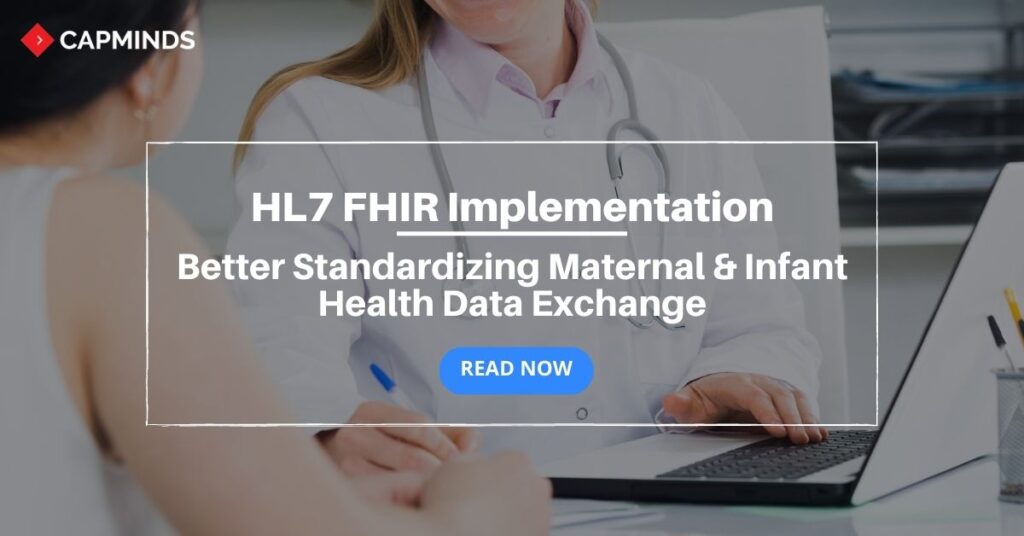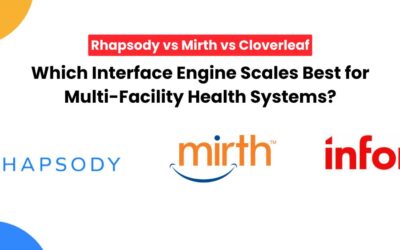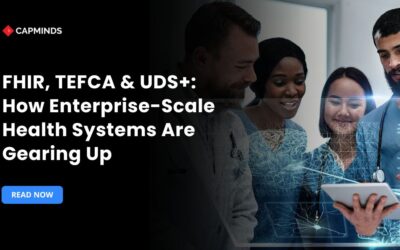HL7 FHIR Implementation: Better Standardizing Maternal & Infant Health Data Exchange
Researchers at the National Institutes of Health (NIH) have released a new FHIR implementation guide for maternal and infant health aimed at standardizing the exchange of clinical data in this domain.
The Maternal & Infant Health Information for Research Implementation Guide has been developed to facilitate the capture, aggregation, and analysis of EHR data from various platforms, specifically for public health research in maternal and infant health. This guide represents a crucial milestone in establishing a framework to comprehend the underlying causes of the persistently high rates of maternal morbidity and mortality that have been escalating across the United States for the past two decades.
RELATED: Top 15 HL7 Integration Challenges & Solutions for 2023
Furthermore, while there is growing evidence indicating the interconnection between maternal and child health outcomes, the country lacks consistent methodologies for analyzing data to comprehend how factors like maternal medical history and social determinants of health (SDOH) impact the well-being of both the mother and the infant.
The Challenge Addressed by HL7 FHIR Implementation Guide
The HL7 FHIR implementation guide, a part of the ongoing Longitudinal Maternal & Child Health Information for Research Project led by NICHD, addresses the challenge of “connecting a mother’s records, regardless of the healthcare system in which she received care, to her infant’s records”. By standardizing the process of accessing longitudinal clinical data from EHRs and providing a codified guide, researchers are empowered to overcome this hurdle and advance their investigations.
The Initial Objective of the Project
The project’s objective was to establish an infrastructure that would enable the exchange and retrieval of EHR data relevant to these use cases among researchers. However, collaboration with partners like the Centers for Disease Control and Prevention (CDC), the Office of the National Coordinator for Health Information Technology (ONC), the NIH National Library of Medicine, and Lantana Consulting Group revealed the need for innovation to facilitate the implementation of the guide.
The Importance of Highly Accessible Clinical Data: The FHIR Customization
- Recognizing the importance of making data readily available to researchers, the consulting group customized an open-source FHIR application previously developed for the CDC
- This served as the foundation for a pilot application named MaternalHealthLink
- Aggregated and deidentified patient data sets, matching the research populations for the maternal health use cases, were provided by HealtheConnections, a health information exchange (HIE) based in New York
- The guide and early versions of MaternalHealthLink were tested and refined through collaborative efforts at two HL7 FHIR Connectathons
By harmonizing connections between maternal and infant health data, advancements in the field of maternal and child health can be achieved.
HL7 FHIR Implementation: How Eases Maternal and Infant Health Data Exchange
1. Standardized Data Model
- FHIR provides a standardized data model based on resources and elements, which allows for consistent representation and exchange of maternal and infant health data
- This standardized model ensures that different systems and applications can understand and interpret the data uniformly
2. Interoperability
- FHIR promotes interoperability by enabling seamless data exchange between various healthcare systems like EHRs, maternity care systems, immunization registries, and more
- FHIR’s RESTful API allows systems to communicate and share data in a standardized way, regardless of the underlying technology or vendor
3. Granularity and Extensibility
- FHIR resources are designed to be granular, meaning that data can be exchanged at a fine-grained level
- This allows for targeted information exchange, focusing on specific aspects of maternal and infant health
- Additionally, FHIR supports extensibility, enabling adding custom fields or data elements specific to the needs of maternal and infant health data exchange
4. Modular Approach
- FHIR follows a modular approach, where data can be exchanged as individual resources or bundles of related resources
- This modular structure allows for incremental data exchange, ensuring that only the necessary data is shared, reducing unnecessary overhead
5. Wide Adoption and Community Support
- FHIR has gained significant traction and adoption in the healthcare industry, with a growing community of implementers and developers
- This extensive community support means there are numerous resources, implementation guides, and tools available to aid in the implementation of FHIR for maternal and infant health data exchange
6. Improved Data Accessibility
- FHIR’s RESTful API makes it easier to access and retrieve specific data elements from maternal and infant health records
- This enhanced accessibility allows authorized healthcare providers to retrieve relevant information quickly and efficiently, supporting timely decision-making and care coordination
6. Cross-System Integration
- FHIR enables integration across different healthcare systems and applications, facilitating the exchange of maternal and infant health data between various stakeholders, including providers, laboratories, public health agencies, and research institutions
- This integration enhances care coordination, research collaboration, and public health monitoring
7. Compliance with Healthcare Standards
- FHIR aligns with various healthcare standards, including HL7 v2, CDA (Clinical Document Architecture), and SNOMED CT
- This compliance ensures seamless integration with existing healthcare systems and promotes data exchange across different standards
The Challenges Faced by Maternal and Infant Health
1. Inconsistent Data Analysis
- There is a lack of consistent ways to analyze data related to maternal and infant health
- This hinders the ability to understand how factors like maternal medical history and social determinants of health impact outcomes for both the mother and the infant
2. High Maternal Morbidity and Mortality Rates
- Maternal morbidity and mortality rates have been increasing nationwide for the past two decades
- Understanding the root causes of these high rates is crucial for improving maternal health outcomes
3. Fragmented Healthcare Systems
- Connecting a mother’s medical records across different healthcare systems and linking them to her infant’s records can be challenging
- It is important to establish a standardized method for accessing longitudinal clinical data from EHRs to overcome this fragmentation
4. Limited Data Exchange
- Researchers face challenges in exchanging and retrieving EHR data to support their studies
- Establishing an infrastructure that facilitates seamless data exchange is essential for advancing maternal and infant health research
5. Need for Innovative Tools
- Simplifying the implementation of the FHIR implementation guide requires innovative tools that expedite the flow of clinical EHR data to researchers
- Building such tools compliant with the guide can enhance data accessibility and ultimately benefit maternal and child health
Solutions for the Challenges Faced by Maternal and Infant Health
1. Standardized Data Analysis
- Develop standardized methodologies and protocols for analyzing maternal and infant health data
- This can include establishing common data elements, data collection tools, and analytical frameworks that allow for consistent analysis and comparison across different studies and settings
2. Research on Root Causes
- Conduct comprehensive research to identify the underlying causes of high maternal morbidity and mortality rates
- This can involve interdisciplinary collaborations, longitudinal studies, and analysis of various factors such as medical history, social determinants of health, and healthcare practices
- Understanding these root causes is crucial for implementing targeted interventions and improving outcomes
3. Integrated Health Information Systems
- Implement integrated health information systems that enable the seamless sharing of maternal and infant health data across providers, facilities, and systems
- This can involve interoperability initiatives and the adoption of standardized health data exchange protocols like HL7 FHIR, allowing for efficient data exchange and continuity of care
4. Data Exchange Infrastructure
- Establish a robust infrastructure for the secure and efficient exchange of electronic health records (EHRs) between researchers and providers
- This can involve the development of data-sharing agreements, data governance frameworks, and secure data access portals that ensure privacy and compliance with regulatory requirements
5. Innovative Tools and Technologies
- Develop user-friendly tools and technologies that facilitate data flow, data aggregation, and data analysis for researchers
- This can include customized FHIR applications, data analytics platforms, and visualization tools that streamline the process of accessing and analyzing EHR data, ultimately accelerating research and improving maternal and infant health outcomes
6. Collaboration and Partnerships
- Foster collaborations among stakeholders including researchers, providers, government agencies, and technology vendors
- By leveraging collective expertise and resources, collaborative efforts can drive innovation, knowledge sharing, and best practices in maternal and infant health research
HL7 Integration Services from CapMinds
CapMinds Technologies offers the perfect all-in-one Health Interoperability solutions for your clinical needs. Our HL7 FHIR services ease the innovatory exchange to create new possibilities. Our client-centered services keep them in the limelight. Our clinical & HL7 integrations enable EHR-integrated laboratory, imaging, e-prescriptions, EPCS, pharmacy, and much more. These enhance the activation process for your individual and collective needs.
“CapMinds Technologies is the place that will make you achieve your goals by combining “Expertise+Hardwork+Commitment”.
CapMinds FHIR APIs services cover your patients’ health data with the greatest security, privacy, and confidentiality. We update ourselves with the latest versions like HL7 Version 2, Version 3, FHIR, SMART on FHIR, CDA, X12, HAPI FHIR, Mirthconnect, and security standards. CapMinds offers the best HL7 integration and HL7/FHIR interface development services for the federal government, health tech startups, laboratories, clinics, and practices.
“Unite with us to get the most benefits of our HL7 integration services and rise to be the first”




